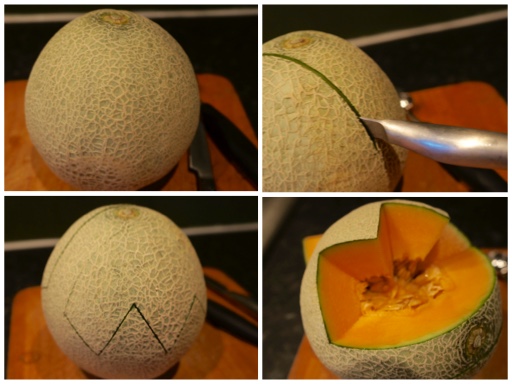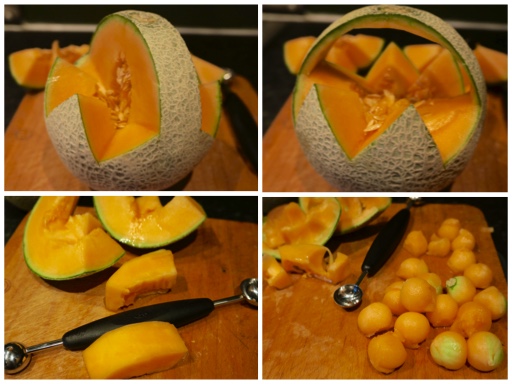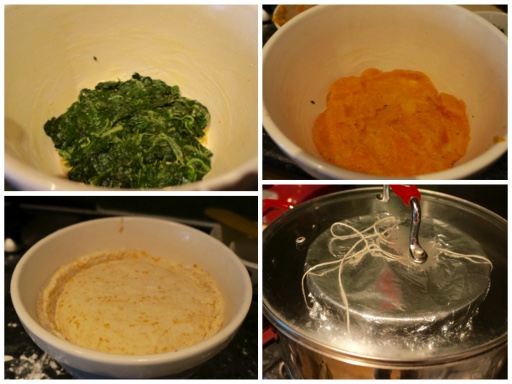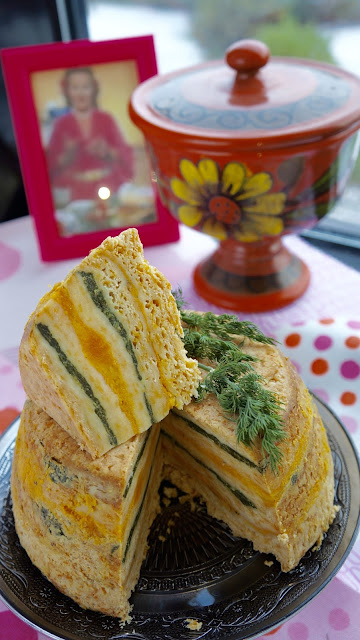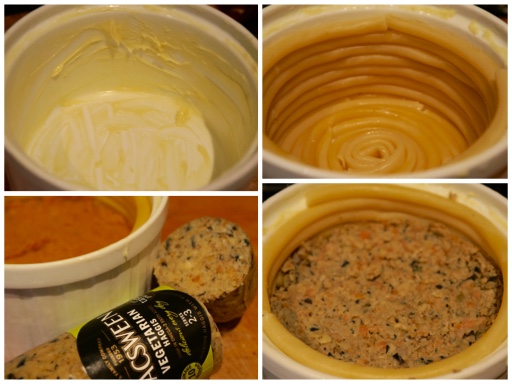I'm sure we've all had days like these. The cupboards are barer than bare and the usually upwardly buoyant inspiration has hit an all-time low. You just want to grab something simple to eat, anything, and not worry one little bit what it looks like. It's not like anyone is going to see it but you, is it? Until there's that unexpected knock at the front door and you remember with horror that you casually invited Mrs so-and-so from the next street along that you never really liked very much round for a bite to eat while showing off your holiday slides. Oh balls! Fix a smile, contain your panic and think 'What Would Fanny Do?'
The inevitable answer is always something erupting with elegance and embellishment, something that the nasty not-bargained-for neighbour would never dream of. Something they would simply have to rave about as the hover over the garden fence to tell the other, intentionally uninvited, neighbours about in great detail. Above all garnish and presentation. As you glance round the kitchen though, while Mrs so-and-so takes a gander round your living room hoping to find specks of dust, or worse, options seem limited. Just a fleshy fruit flashing a wink at you from the counter-top... If all life gives you is a melon, what on earth do you do?
Fanny says balls, naturally. Melon balls. Always classy, fresh and zingy. But are they dramatic enough? Will Mrs so-and-so really be impressed with a pile of balls? Fanny clearly thinks 'no'. Her answer is to make an overblown feature of the melon itself, pulling on all her creative powers to fashion it into a basket to cradle the otherwise 'everyday' balls. Pesky Mrs so-and-so will never believe it...
Knife skills are key here, first of all marking out the handle for the basket, then slowly and carefully creating an overly exaggerated jagged edge, you know, erm, like all baskets have. Slicing ever-so-carefully around the design to release two sections of melon either side of that 'handle'. Then trim out under the arch, and scoop out the seeds, no-one would be impressed with those. Grab your melon baller (which I presume is never far from hand) - although do remember when Mrs so-and-so asks it's called a Parisian cutter - and swirl those off-cuts into the spherical star turn. That'll show Mrs so-and-so, I bet she's never eaten melon balls from an actual melon basket...
Fanny does not stop there of course, always a footstep ahead when it comes to flaunting fruit. She identifies a deserted tin of mandarin oranges sitting all lonesome in the bleak kitchen cupboard. But how can you serve tinned fruit to Mrs so-and-so and get away with it. Taking girl power as her inspiration (no doubt) the answer, as ever when uncertain, is to spice up your life. Fanny gently heats the mandarins with water, sugar and cinnamon before serving them 'icy' cold. Luckily for me my store cupboards also have some mulled wine Spice Drops, so I just add them to the juice and slosh it on. No need to gently heat and chill. Made in minutes, Mrs so-and-so will be lost for words. So, get carving and balls to her.
Monday, 25 January 2016
Monday, 18 January 2016
Pudding on the Brits
I don't know about with you, but it's been snowing here in Edinburgh this weekend, so something totally warming, perhaps stodgy and oh-so comforting is required. Quick as a flash, Fanny flies in with her long-forgotten solution, native to these isles and once found on almost all kitchen tables - the steamed pudding. A savoury one to boot. She claims it's one of her very favourites, as it has cheese in the crust, but of course she puts her own special twist on it to help with the presentation...
Fanny says she's flicked through all the cookery books she owns (which I imagine are simply the ones she has written herself) and despite all her furious research, she has been unable to find anything even remotely similar to this, ever, in history. She's not claiming to have invented this one, she does recognise that she may have seen it somewhere, she is just not sure where or when. This does not stop dear old Fanny from unveiling it to the world.
Fanny's savoury crust of course uses proper, everyday, honest to goodness suet. No-one would ever need to explain it, or indeed have any consideration that you may not be happy to eat it. Thank heavens for a vegetarian version courtesy of Atora snuggling away in my cupboard waiting for such a weekend as this. Once nestled in with the flour (self-raising as Fanny always insists), some additional baking powder, a little seasoning, a whole load of cheese and 'enough' cold water to make a good stiff dough no-one would ever be able to tell anyway. I love a suet dough, it's so manageable and as I've used bright red cheese in this one, you can really see the flecks as your roll it. I'm feeling warm and cheery already.
Fanny fills her pudding with beef. pork or veal, so I swap that for some frozen vegetables. It seems appropriate for this oh-so freezing weekend. Fanny herself was a fan of the freezer too, so I'm not going to feel too badly. All seems fine. I fling the spinach and butternut squash into pans (separate ones) and cook them down. The squash goes all squishy, but that's fine as I want a very rough purée, honest. To both I add a touch of seasoning and a grind of fresh nutmeg. Oh and egg yolks, just like Fanny does to her meat. I wonder of she made hers look like google eyes too? Actually, probably.
Any normal suet pudding, even a savoury one, Fanny notes, would start off with the pastry lining the well buttered bowl. Not here. Oh no. Fanny builds up layers in stripes of cheesy suet crust and filling, cutting suet discs in every increasing circles to fit the bowl. Fanny steams the pudding for two and a half hours before unmoulding. She does warn that these puddings are not for the faint hearted or those nervous of turning them out in front of guests. If you fall into these categories, Fanny recommends that you serve it just from the bowl, with a clean napkin wrapped around it, or revert back to an old fashioned style pudding, with the bowl lined and filling inside. I think in giving such an instruction most readers would quiver and cave in. But why would you pass the opportunity to slice into this striped beauty and wow your guests, not only with the taste but with the style too. Please don't be a pudden and allow suet puddings to remain forgotten, they really are so very perfect for a winters treat.
Fanny says she's flicked through all the cookery books she owns (which I imagine are simply the ones she has written herself) and despite all her furious research, she has been unable to find anything even remotely similar to this, ever, in history. She's not claiming to have invented this one, she does recognise that she may have seen it somewhere, she is just not sure where or when. This does not stop dear old Fanny from unveiling it to the world.
Fanny's savoury crust of course uses proper, everyday, honest to goodness suet. No-one would ever need to explain it, or indeed have any consideration that you may not be happy to eat it. Thank heavens for a vegetarian version courtesy of Atora snuggling away in my cupboard waiting for such a weekend as this. Once nestled in with the flour (self-raising as Fanny always insists), some additional baking powder, a little seasoning, a whole load of cheese and 'enough' cold water to make a good stiff dough no-one would ever be able to tell anyway. I love a suet dough, it's so manageable and as I've used bright red cheese in this one, you can really see the flecks as your roll it. I'm feeling warm and cheery already.
Fanny fills her pudding with beef. pork or veal, so I swap that for some frozen vegetables. It seems appropriate for this oh-so freezing weekend. Fanny herself was a fan of the freezer too, so I'm not going to feel too badly. All seems fine. I fling the spinach and butternut squash into pans (separate ones) and cook them down. The squash goes all squishy, but that's fine as I want a very rough purée, honest. To both I add a touch of seasoning and a grind of fresh nutmeg. Oh and egg yolks, just like Fanny does to her meat. I wonder of she made hers look like google eyes too? Actually, probably.
Any normal suet pudding, even a savoury one, Fanny notes, would start off with the pastry lining the well buttered bowl. Not here. Oh no. Fanny builds up layers in stripes of cheesy suet crust and filling, cutting suet discs in every increasing circles to fit the bowl. Fanny steams the pudding for two and a half hours before unmoulding. She does warn that these puddings are not for the faint hearted or those nervous of turning them out in front of guests. If you fall into these categories, Fanny recommends that you serve it just from the bowl, with a clean napkin wrapped around it, or revert back to an old fashioned style pudding, with the bowl lined and filling inside. I think in giving such an instruction most readers would quiver and cave in. But why would you pass the opportunity to slice into this striped beauty and wow your guests, not only with the taste but with the style too. Please don't be a pudden and allow suet puddings to remain forgotten, they really are so very perfect for a winters treat.
Monday, 11 January 2016
Feel the Appeal of the un-Real Meal
Fanny often wants to convince us that she is the undeniable, bona fide, irrefutable real deal when it comes to recipes, techniques, knowledge and skill. This is the entire basis of the partwork series, she is sharing her veritable gifts with us. At times she is blatantly blunt in telling us that her way is the right way. Other times she is, honestly, a little more subtle but absolutely as concrete in her message. For a simple dish of Shepherds Pie she takes us back in time to Old England to discover what this traditional pie meant to our ancestors, but makes it evident that we have been making it wrongly all these years by the simple addition of a single word. This is Fannys' Real Shepherds Pie.
Well it would be if I wasn't insistent on fiddling with the recipe, twiddling out the meat and tiddling it up for vegetarians. Fanny uses a tangible mixture of cold, cooked lamb or mutton and finely minced lean gammon as the base for her pie, I use a packet of ready cooked Puy Lentils. So handy, and I think still valid, still in the spirit of the dish - a quick transformation of so-called leftovers and cupboard staples. It happens to be International Year of Pulses too, whoever knew that such a thing should exist. If Fanny were here in 2016 I am sure she'd celebrate with a special book. Or two. Or three.
Fanny mixes her meat with a grated onion, freshly milled parsley, a little stock and seasoning, so do I with the newly elevated, internationally celebrated, legitimate lentils. I was clearly 'keeping it real' during the preparation too, as the grating of the onion resulted in streams of actual tears in the kitchen that simple chopping alone would not have uncovered. It seems a little odd to grate them in the first place and not cook them, but was we know Fanny is indubitable, so I don't question it.
It's all seemingly fairly standard so far, no hints of the 'real' nature that Fanny promised with the pie. The filling goes into a dish and Fanny urges us to get on with the topping. Surely just mashed potato? Everyone knows that a Shepherds Pie is topped with mashed potato, don't they? Think again, authentic fans, Fanny has some flour up her sleeve. She does mash up her pre-prepared steamed (of course, never boiled) potatoes, adds some butter and boiling milk. Then she beats to a smooth paste before working in the flour to create a pastry paste consistency. She rolls it out and tops the pie with it. I was hoping for piping.
Fanny calls this Potato Crust. She finishes it off by marking it in a criss cross fashion with a hot, wet knife in trellis lines. Then a quick brush with egg wash before the oven. The pie emerges well risen, and quite, well, crusty looking. It's an original texture, both fluffy and crispy and tucked underneath are the simply flavoured pulses, shining and singing among the parsley and the sweet grated onions. All-in-all it's a delightful pie. We only have Fannys word that this is the truly defacto real deal. I'm happy to just enjoy the pie. Who would question Fanny anyway?
Well it would be if I wasn't insistent on fiddling with the recipe, twiddling out the meat and tiddling it up for vegetarians. Fanny uses a tangible mixture of cold, cooked lamb or mutton and finely minced lean gammon as the base for her pie, I use a packet of ready cooked Puy Lentils. So handy, and I think still valid, still in the spirit of the dish - a quick transformation of so-called leftovers and cupboard staples. It happens to be International Year of Pulses too, whoever knew that such a thing should exist. If Fanny were here in 2016 I am sure she'd celebrate with a special book. Or two. Or three.
Fanny mixes her meat with a grated onion, freshly milled parsley, a little stock and seasoning, so do I with the newly elevated, internationally celebrated, legitimate lentils. I was clearly 'keeping it real' during the preparation too, as the grating of the onion resulted in streams of actual tears in the kitchen that simple chopping alone would not have uncovered. It seems a little odd to grate them in the first place and not cook them, but was we know Fanny is indubitable, so I don't question it.
It's all seemingly fairly standard so far, no hints of the 'real' nature that Fanny promised with the pie. The filling goes into a dish and Fanny urges us to get on with the topping. Surely just mashed potato? Everyone knows that a Shepherds Pie is topped with mashed potato, don't they? Think again, authentic fans, Fanny has some flour up her sleeve. She does mash up her pre-prepared steamed (of course, never boiled) potatoes, adds some butter and boiling milk. Then she beats to a smooth paste before working in the flour to create a pastry paste consistency. She rolls it out and tops the pie with it. I was hoping for piping.
Fanny calls this Potato Crust. She finishes it off by marking it in a criss cross fashion with a hot, wet knife in trellis lines. Then a quick brush with egg wash before the oven. The pie emerges well risen, and quite, well, crusty looking. It's an original texture, both fluffy and crispy and tucked underneath are the simply flavoured pulses, shining and singing among the parsley and the sweet grated onions. All-in-all it's a delightful pie. We only have Fannys word that this is the truly defacto real deal. I'm happy to just enjoy the pie. Who would question Fanny anyway?
Monday, 4 January 2016
Lankee Noodle Dandy
Fanny Cradock calls this partwork 'Everyday Puddings and Pies', proudly telling us that we will be keeping our culinary toes very firmly on the ground as we add to our currently limited collection of 'pastes' with an infinite variety of new ones. Never miss an opportunity to remind us of our position. Fanny warns us that if we wish to be very fine cooks we will need to have many types at our disposal - our current repertoire of bought puff paste, sweet and savoury short pastes, ravioli paste (which I assume is pasta), basic suet paste and raised pie paste are simply not sufficient. Her aim is to prepare us for the holy grail in a future part that we can tackle together - homemade puff paste - but meanwhile we must confine ourselves to easy and simple ones.
It is somewhat of a surprise therefore to discover that this particular 'pie' has no pastry whatsoever. Fanny says we must leave the shores of this fine land and travel to France for a pie that is so very special it doesn't even have a name in English. Defying translation, we must tackle the Timbale. Fanny describes it as an economical main course 'dish' (so it's not a pie?) which is steamed in an overcoat of blanched macaroni. Maybe this is a steamed pudding then rather than a pie? Hang on, did she say Macaroni? A Macaroni Pie?
Fanny makes hers with smoked haddock, duchess potatoes (presumably green), tomatoes and boiled eggs, which seem to be appearing in everything these days. I'm switching mine up Scottish-style with vegetarian haggis, neeps and, erm, sweet potatoes. But first the so-called 'macaroni'. Fanny says to use the 'thick' kind which in her picture looks extremely long. I search high and low for long and thick, believe me. My local Italian deli comes to the rescue with Mezzo Ziti which I think is the right thing.
Fanny recommends cooking it in a roomy pan of boiling water, slipping it in very slowly so that it softens as it goes and does not break up. If it does, Fanny insists we must start again. It becomes clear why soon enough. Simmer for a mere five minutes before immediately removing, draining and immersing it into a bowl of very cold water. It should be just pliable. Fanny has ready a buttered soufflé mould and begins to coil the macaroni around the bottom, and then up around the sides. Ah-ha, broken bits will never do. It sticks well to the butter and to it's neighbouring strand of pasta while still 'just cooked'. Then layer up the filling - I start with the sweet potatoes, then the haggis and finally the neeps.
Fanny then covers the whole dish with buttered papers and steams it for around 35-40 minutes. The covering needs to be removed and the dish allowed to settle for 3 or maybe 4 minutes. Fanny warns it will be piping hot, just incase you weren't sure, so don't touch it. Lay a serving dish on the top, quickly invert it and give it a gentle shake - it should slide out well, providing you have buttered your soufflé dish thoroughly. Thankfully I have. It looks quite impressive actually, just like Fanny's own picture, adding a little flair and winter carbs to my usual haggis presentation. To add a wee Scottish kick, I serve with some Scottish Chilli Rocks from Galloway Chillies, which I bought on a recent trip to the lovely named Kirkcudbright, made with Scottish Gin from Rock Rose. Perfect combination. It does collapse a little (but only a little, honest) when you cut it, but the stripes of filling are appealing. The only thing I forgot was to stick a feather in it, but let's still call it a somewhat different, somewhat special, somewhat not-everyday, Scottish (maybe French, maybe Italian) Macaroni Pie.
It is somewhat of a surprise therefore to discover that this particular 'pie' has no pastry whatsoever. Fanny says we must leave the shores of this fine land and travel to France for a pie that is so very special it doesn't even have a name in English. Defying translation, we must tackle the Timbale. Fanny describes it as an economical main course 'dish' (so it's not a pie?) which is steamed in an overcoat of blanched macaroni. Maybe this is a steamed pudding then rather than a pie? Hang on, did she say Macaroni? A Macaroni Pie?
Fanny makes hers with smoked haddock, duchess potatoes (presumably green), tomatoes and boiled eggs, which seem to be appearing in everything these days. I'm switching mine up Scottish-style with vegetarian haggis, neeps and, erm, sweet potatoes. But first the so-called 'macaroni'. Fanny says to use the 'thick' kind which in her picture looks extremely long. I search high and low for long and thick, believe me. My local Italian deli comes to the rescue with Mezzo Ziti which I think is the right thing.
Fanny recommends cooking it in a roomy pan of boiling water, slipping it in very slowly so that it softens as it goes and does not break up. If it does, Fanny insists we must start again. It becomes clear why soon enough. Simmer for a mere five minutes before immediately removing, draining and immersing it into a bowl of very cold water. It should be just pliable. Fanny has ready a buttered soufflé mould and begins to coil the macaroni around the bottom, and then up around the sides. Ah-ha, broken bits will never do. It sticks well to the butter and to it's neighbouring strand of pasta while still 'just cooked'. Then layer up the filling - I start with the sweet potatoes, then the haggis and finally the neeps.
Fanny then covers the whole dish with buttered papers and steams it for around 35-40 minutes. The covering needs to be removed and the dish allowed to settle for 3 or maybe 4 minutes. Fanny warns it will be piping hot, just incase you weren't sure, so don't touch it. Lay a serving dish on the top, quickly invert it and give it a gentle shake - it should slide out well, providing you have buttered your soufflé dish thoroughly. Thankfully I have. It looks quite impressive actually, just like Fanny's own picture, adding a little flair and winter carbs to my usual haggis presentation. To add a wee Scottish kick, I serve with some Scottish Chilli Rocks from Galloway Chillies, which I bought on a recent trip to the lovely named Kirkcudbright, made with Scottish Gin from Rock Rose. Perfect combination. It does collapse a little (but only a little, honest) when you cut it, but the stripes of filling are appealing. The only thing I forgot was to stick a feather in it, but let's still call it a somewhat different, somewhat special, somewhat not-everyday, Scottish (maybe French, maybe Italian) Macaroni Pie.
Subscribe to:
Comments (Atom)


